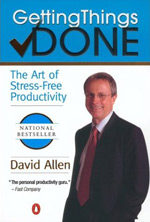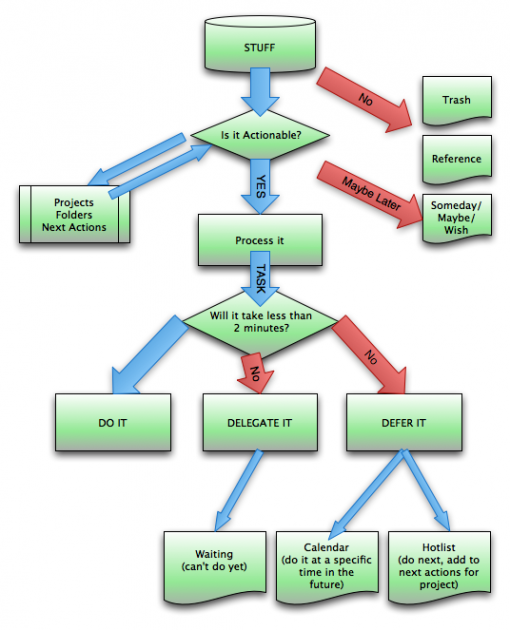
A bit easier said than done, right? This book grabs the ideals adding time back to your day. In fact, if you look at GTD or the “Getting Things Done” principals, you will almost find a cult of people who live by these principles. There’s apps in the app store in regards to the methodologies. SO, yes, some people live and die by it.
Overall, the book really puts PURPOSE behind our workday. Here’s the highlights:
- – Visualize the desired outcome. What’s the next actionable item to get there
- – Action Items need to be actionable and a clear beginning and end:
- – What’s the very next physical process that needs to be done to move this along:
- – Have to clean the garage? The item should be setup in components: Remove old paint, Organize Shelves
- – Only handle things once
- – Do it: Quit being a burden. Just get it done. (2 min or less)
- – Delegation – Are you the best person to be doing the work? If not, delegate.
- – Defer: Make a project with an “Next Action” item. Or… Setup a time around it.
- – Dump it: Don’t commit
- – Develop “Next Action” lists, not “To-Do Lists”
- – Anything you consider unfinished in anyway adds to your stress. You need to make everything actionable. You can train yourself, like an athlete, to be faster, more responsive, more proactive, and more focused.
- – Setup time each week to keep things flowing. Chi Time. So you feel comfortable with your tasks. Review Next Action list. Review Waiting For Lists. And remove the negative stress
Steps for planning
- – Purpose: Defining the why. Brings value to the outcome/to the goal.
- – Focus: You won’t see how to do it until you see yourself doing it.
- – Outcome: This is the end goal. It gives focus. It’s the tangible, end result.
- – Plan: The area that fills the gap of where are today and where you want to go.
- – Actionable Items: What steps will move along the project to the desired outcome.
Other notables:
- – Your mind should be like water. “How does water respond? The answer is totally appropriately to the force and mass of then it returns to calm. It doesn’t overreact; it doesn’t under react. ” Anything that causes you to overreact or underreact can control you.
- – Plans help close the gap. Gaps are where you’re looking at, and your current state. This is the importance of visualizing the outcome. Show where you are, and show where you need to be.
- – Think of project that’s stuck. Think of the purpose. Think of the successful outcome. Brainstorm the steps. Organize the ideas. And then decide next actions.
- – Save time with Keyboard shortcuts and quit messing with the mouse as much.
- – Keep agenda lists. For your meetings; for impromptu meetings with people; for your travel.
- – Get out of the reactive mode. e.g. Email -> React Quickly. This creates stress. PRocess things within the prioritized, natural process. Eliminate reactive.
- – Review the high level items to make sure what you’re doing makes sense. Is your job aligned with your life? Does your daily work align with the promotion you want to receive.
- – Take advantage of “weird” time. e.g. Flights, Meetings, Walking to Lunch… Call people then; process email, etc.
- – Visualize where you want to be in 12 months, 36 months, etc. Is what you’re doing going to get you there.
- – Purpose vs. Goals vs. Tasks
- – Maintenance vs. Management vs. Growth

